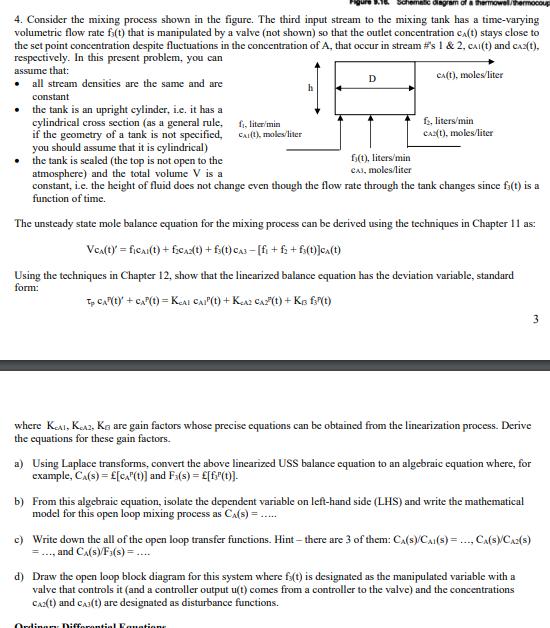Answered step by step
Verified Expert Solution
Question
1 Approved Answer
wel/thermocoup 4. Consider the mixing process shown in the figure. The third input stream to the mixing tank has a time-varying volumetric flow rate

wel/thermocoup 4. Consider the mixing process shown in the figure. The third input stream to the mixing tank has a time-varying volumetric flow rate fs(t) that is manipulated by a valve (not shown) so that the outlet concentration cx(t) stays close to the set point concentration despite fluctuations in the concentration of A, that occur in stream #'s 1 & 2, CAI(t) and c^2(t), respectively. In this present problem, you can assume that: all stream densities are the same and are constant the tank is an upright cylinder, i.e. it has a cylindrical cross section (as a general rule, if the geometry of a tank is not specified, you should assume that it is cylindrical) the tank is sealed (the top is not open to the atmosphere) and the total volume V is a fi, liter/min D h CA(t), moles/liter Cai(t), moles/liter f, liters/min CA(1), moles/liter fi(t), liters/min CAS, moles/liter constant, i.e. the height of fluid does not change even though the flow rate through the tank changes since fi(t) is a function of time. The unsteady state mole balance equation for the mixing process can be derived using the techniques in Chapter 11 as: Vex(t) = fic(t) + fc2(t) +fs(t) CA3-[fi+f+fs(t)]cx(t) Using the techniques in Chapter 12, show that the linearized balance equation has the deviation variable, standard form: Tp CAP(t) + CAP(t)=KAI CAI"(t) + KA2 CA2(t) + K fi(t) where KCAL, KA2, Ko are gain factors whose precise equations can be obtained from the linearization process. Derive the equations for these gain factors. a) Using Laplace transforms, convert the above linearized USS balance equation to an algebraic equation where, for example, Ca(s) = [CA"(t)] and Fx(s) = [f;"(t)]. b) From this algebraic equation, isolate the dependent variable on left-hand side (LHS) and write the mathematical model for this open loop mixing process as CA(S)=..... c) Write down the all of the open loop transfer functions. Hint - there are 3 of them: CA(s)/CAI(s) = .... CA(s)/CA2(s) =, and Cx(s)/F(s)=.... d) Draw the open loop block diagram for this system where fx(t) is designated as the manipulated variable with a valve that controls it (and a controller output u(t) comes from a controller to the valve) and the concentrations CA2(t) and cx3(t) are designated as disturbance functions. Ordinary: Differential Equations 3
Step by Step Solution
There are 3 Steps involved in it
Step: 1

Get Instant Access to Expert-Tailored Solutions
See step-by-step solutions with expert insights and AI powered tools for academic success
Step: 2

Step: 3

Ace Your Homework with AI
Get the answers you need in no time with our AI-driven, step-by-step assistance
Get Started


